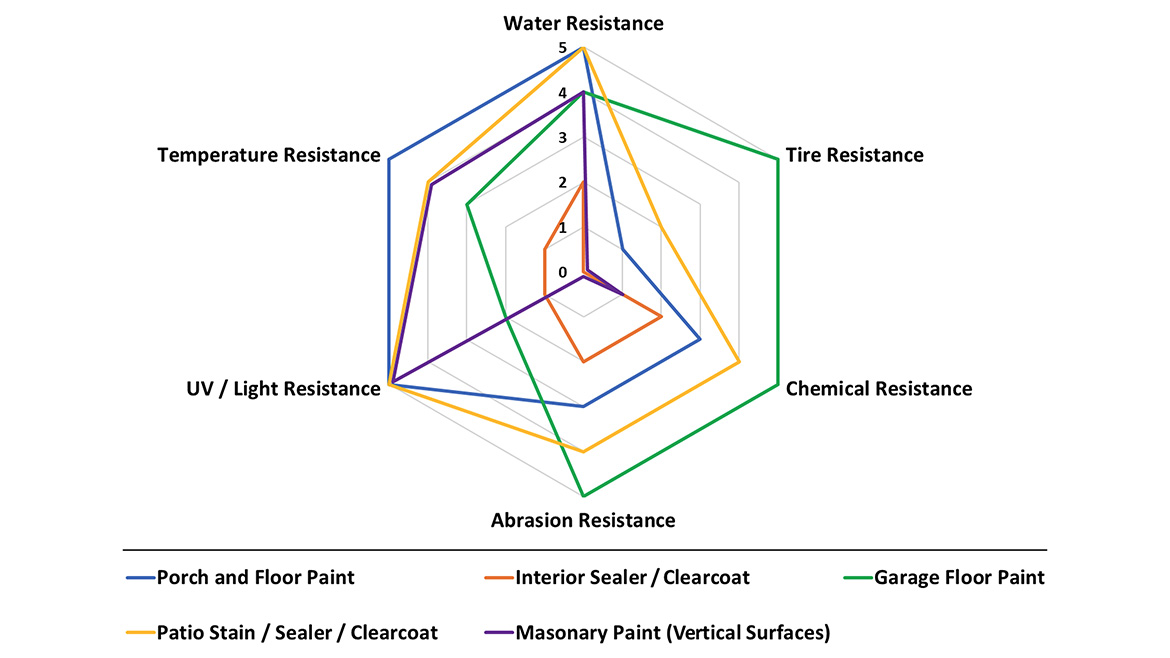Concrete Coatings, Part II
Properties Needed

Example of efflorescence. Credit: Courtesy of Michael Praw
The first part of this series covered concrete as a substrate. Now we will continue with coating concrete. We will concentrate on different properties needed by different DIY coating types and testing them.
Concrete coatings have certain requirements depending on the coating type, but most coatings have these properties:
- Water resistance and wet adhesion
- Abrasion resistance
- Chemical and stain resistance
- Exterior durability
- Tire resistance
The main performance differences are dependent on the application, and how the concrete is being used. Garage floors and other nonindustrial coated surfaces that encounter automobile traffic require tire resistance, water resistance, abrasion resistance and chemical resistance to household chemicals and automotive fluids. Patio stains, sealers and paints need water and abrasion resistance, as well as good antistain properties. Porch and floor coatings require water resistance and need to have good wear properties. Masonry wall coatings are not designed for heavy abuse, so have very different properties than floor coatings. Any exterior coating requires excellent exterior durability. Temperature resistance is also needed for exterior coatings, especially when the coating must go over other substrates with dimensional instability such as wood. Thus, the end use of the coating determines what balance of properties is needed.

Tire-Resistance Testing
Since there is no standard test method for tire resistance, test methods have been improvised. Tire resistance testing of coatings is difficult to perform in a reproducible manner that also represents what will happen in real-life situations. Tire resistance can also mean different things to different people: Is it brown staining from the tall oils used to plasticize tires? Is it deformation of the film from the weight of the vehicle? Is it adhesion to the substrate when the tire is moved after a prolonged period of resting on the coating? Or a balance of all three?
When simulating tire resistance, it's important to consider the type of tire used in the test. A soft-performance tire contains a higher level of plasticizers, which increases the potential for staining and enhances adhesion to the coating, ultimately leading to a loss of adhesion to the concrete. Additionally, the required tire pressure is a factor, as different tire designs have varying ratios of rubber to voids that make contact with the coating.
A softer (lower Tg or MFFT) coating will generally have poorer tire resistance. This is due to easier deformation, and the softer monomer used will be more hydrophobic and will stain more easily from plasticizer migration from the tire. This plasticizer migration will further soften the coating, leading to a death spiral for the coating. However, the softer, more-hydrophobic coatings will have better water resistance.
With low-VOC regulations, the move to softer resins will pose additional issues for coatings formulators. Often a tire is cut and put into a press and placed in an oven to simulate reality. However, concrete is a heat sink, so within a short timeframe the tire in contact with the coating will be at the temperature of the concrete. Testing should take place at the temperature range in which the coating is designed to operate.
Water-Resistance and Wet-Adhesion Testing
Water testing is very important, as water-based coatings tend to have higher water sensitivity than solvent-based ones. Often evaluated are wet adhesion to concrete (x-scribe and tape pull), softening of the film and blush resistance. It is important not to test blush resistance on a white coating, as blush will not be visible. It is also very important to check the coating after 24 hours of recovery because many coatings fail upon drying.
For water testing on concrete, the following tests are recommended:
- Early Water Resistance: This is tested with a water spot at 2, 4, 6, 8 and 24 hours after application to represent rain on an exterior coating. Test length (water spot exposure time) is usually one hour.
- Water Resistance: Water-resistance testing is conducted at 1, 3, 7, 14 and 30 days after the coating is applied on a concrete substrate and is submerged in water for 24 hours. Often evaluated are wet adhesion to concrete (x-scribe and tape pull), softening of the film and blush resistance.
Chemical Testing
An effective chemical resistance test differentiates between coatings. If all coatings pass or fail, or if the chemicals used are not relevant, the test results will be meaningless. The following chemicals do differentiate 1K acrylic coatings: mustard, red wine, barbeque sauce, brake fluid (DOT 3), gasoline, isopropanol, muriatic acid and window cleaner. Radiator fluid, power steering fluid, coffee and other chemicals do not show significant differentiation.
One-component concrete coatings need different properties depending on their application and end use. Because of the different requirements of professional contractors and consumers, there are limits on which technologies work for both, and further limits on the number of products that need to be produced. The most cost-effective solution for coatings companies is one coating that can be used for different applications by different types of users.
My next column will investigate coatings chemistries, including two-component formulations.
All information contained herein is provided "as is" without any warranties, express or implied, and under no circumstances shall the author or Indorama be liable for any damages of any nature whatsoever resulting from the use or reliance upon such information. Nothing contained in this publication should be construed as a license under any intellectual property right of any entity, or as a suggestion, recommendation, or authorization to take any action that would infringe any patent. The term "Indorama" is used herein for convenience only, and refers to Indorama Ventures Oxides LLC, its direct and indirect affiliates, and their employees, officers, and directors.
Looking for a reprint of this article?
From high-res PDFs to custom plaques, order your copy today!





